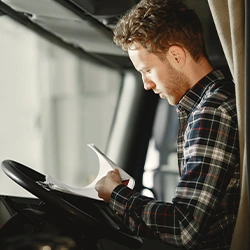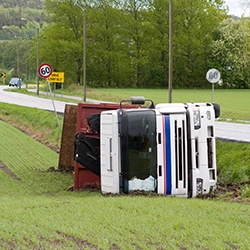Need to drive a box truck, but not sure about CDL requirements? We'll help you quickly determine if you need a commercial driver's license and understand the legal requirements for safe operation
Schmidt & Clark, LLP lawyers have dealt with countless CDL license cases. We’ve been practicing law for two decades, and our services are available across the US.
This means we’re familiar with CLD laws in each state. So, today, we’ll explain do you need a CDL to drive a box truck and who’s at fault for a box truck accident.
Quick Summary
- Whether you’ll need a CDL to drive a box truck depends on the truck’s GVWR.
- You have to know how to check the GVWR and how to calculate it.
- If you get into an accident with your truck, the police will determine who’s at fault.
How to Check if You Need a CDL to Drive a Box Truck?

However, if the truck driver doesn’t have the paperwork, it’s easy to check the GVWR.
A sticker inside the door jamb should say what’s the Gross Axle Weight Rating.
You’ll see two numbers on the sticker. One for the front axle and another for the rear axles.
You should add the two numbers together to get the GVWR. Based on this number, you’ll know whether you should get a CDL for your truck.
If you don’t feel like doing math, there’s another option. You can Google your large box truck's Gross Axle Weight Rating, and you’ll get the answer in seconds.
Or, to be on the safe side, you can contact the truck manufacturer and ask them for the GVWR.
Legal Requirements: Do You Need a CDL to Drive a Box Truck?

But, if your box truck is big and heavy, you’ll need a CDL. To determine if you need a CDL to drive your box truck, you have to check the GVWR.
GVWR is Gross Vehicle Weight Rating or, in other words, this is the highest amount the truck can weigh, including cargo, and still be operational [1].
There are three kinds of CDLs: A, B, and C [2].
Class A CDL Gross Vehicle Weight Rating refers to:
- The driver can operate any vehicle with a semi-trailer or a trailer with at least two axles.
- The GVWR isn’t over 26,000 pounds.
This means you don’t need a GVWR if your vehicle is under 26,000 pounds.
Class B CDL Gross Vehicle Weight Rating box truck driver's license refers to:
- If the GVWR is higher than 26,000 pounds.
- If a vehicle towing another vehicle doesn’t exceed 10,000 pounds.
There’s also a C CDL, but this one is only for carrying special cargoes, and you don’t need C CDL to drive box trucks.
“There are three classes of CDLs that determine the kinds of vehicles you’re permitted to drive: Class A, Class B, and Class C. CDL classification is also determined by the vehicle's gross vehicle weight rating (GVWR) and other specific requirements.” - Driving Tests
If your box truck’s GVWR exceeds 26,000 pounds (even at 26,001), a CDL is required, regardless of truck length.
GVWR refers to the truck’s rated capacity, not its actual weight, so cargo type doesn’t impact this rating.
A 24-foot truck can typically carry 10,000 lbs, and a 26-foot truck around 12,000 lbs. Ensuring compliance with GVWR, licensing, and other requirements helps maintain safety and avoid penalties.
Here’s are other things you need to know about license types, penalties for violations, insurance requirements, and employer obligations.
License Types Needed
- CDL Requirements: A CDL is required for box trucks with a GVWR over 26,001 pounds.
- Class B CDL: Sufficient for most single box trucks, while Class A covers towing larger trailers.
- Non-CDL License: Usually applies to box trucks under 26,001 pounds, but check local laws.
Insurance Requirements
- Liability Insurance: Mandatory minimum for all drivers.
- Cargo Insurance: Necessary for transporting valuable goods.
- Employer’s Responsibility: Ensures coverage for employee drivers.
Employer Obligations
- License Verification: Employers must confirm drivers have valid licenses.
- Training Programs: Safe driving practices are encouraged.
- Compliance: Regular vehicle maintenance and safety checks are required.
What is a Box Truck?

While most box trucks differ in size and shape, all of them have an extended chassis with a box permanently attached. This box is what gives box trucks their name.
These are the characteristics of a box truck:
- Cargo box bolted to the chassis
- The cargo box is completely separate from the cab and can’t be accessed from the cab
- There’s a rear roll-up door
Box trucks are also called straight trucks because they are essentially one long piece of equipment — they don’t have two parts, such as a semi-trailer or other trucks.
Most box trucks are used for deliveries because of their smaller size. They need less gas and are easier for the truck driver to maneuver and park when delivering goods.
Most box trucks are used as:
- Moving trucks — U-Haul rents come in different sizes, and you can drive them yourself.
- Delivery trucks — E.g. FedEx.
- Service trucks — Cleaners, plumbers, and electricians often use them, as they can fit all of their equipment.
- Rental business trucks — For example, event rental businesses use them to deliver and pick up party items, tents, chairs, and more.
How to Drive a Box Truck?
Driving a box truck can be daunting, especially for inexperienced drivers.
To ensure safety on the road, it is essential to follow specific guidelines and be aware of potential hazards.
Below is an expanded safety section that includes a pre-trip inspection checklist, typical hazards, and loading guidelines.
Pre-Trip Inspection Checklist
Before hitting the road, conduct a thorough pre-trip inspection of the box truck. This ensures that the vehicle is safe and ready for operation.
Here’s a checklist to follow:
- Exterior Inspection:
- Check for any visible damage to the truck body.
- Inspect tires for proper inflation and tread depth.
- Ensure all lights (headlights, brake lights, turn signals) function.
- Fluid Levels:
- Check engine oil, coolant, brake fluid, and windshield washer fluid levels.
- Look for any leaks under the vehicle.
- Brakes:
- Test the brakes to ensure they respond appropriately.
- Check the brake pads for wear.
- Mirrors and Windows:
- Adjust mirrors for optimal visibility.
- Ensure windows are clean and free of obstructions.
- Safety Equipment:
- Verify that safety equipment (fire extinguisher, first aid kit, warning triangles) is present and accessible.
Common Hazards To Look Out For
- Blind Spots: Box trucks have more prominent blind spots than standard vehicles. Always check mirrors before changing lanes or merging.
- Low Overpasses: Be aware of height restrictions when driving under bridges or overpasses to avoid collisions.
- Narrow Roads: Exercise caution when navigating narrow streets or tight turns; be prepared to stop if necessary.
- Weather Conditions: Adjust driving behavior in adverse weather conditions (rain, snow, fog) by reducing speed and increasing the following distance.
Loading Guidelines
- Weight Distribution: Ensure that cargo is evenly distributed throughout the truck to maintain balance and stability while driving.
- Secure Cargo Properly: Use straps or nets to secure loads and prevent shifting during transit.
- Know Weight Limits: Be aware of the truck’s weight limit and do not exceed it to avoid handling issues and potential accidents.
- Check Load Before Driving: Perform a final load check before departing to ensure everything is secured correctly.
Driving a box truck requires careful attention to safety protocols and awareness of potential hazards on the road.
By following these steps, drivers can significantly reduce risks associated with operating larger vehicles:
- a pre-trip inspection checklist
- employing safe driving tips
- recognizing common hazards
- practicing accident prevention strategies
- adhering to proper loading guidelines
Who’s at Fault for a Box Truck Accident?

The driver gets the blame because they are the person behind the wheel, and the company gets the blame because they didn’t take adequate measures.
The company must ensure they give box trucks to responsible drivers.
They must also ensure the box trucks are safe to drive and the maintenance is current.
This includes tire and oil changes and other upkeep. The driver is responsible for driving responsibly and possesses the necessary driving skills.
However, in some cases, a third party can be responsible for the accident. For example, if a third party was overtaking where it’s not allowed or recommended.
After an accident with box trucks, police officers will create a timeline of events to establish who was at fault.
You should hire a lawyer to make sure your rights are protected and to help you get an insurance payout.
Legal Consequences of Driving a Box Truck Without a Required CDL
Driving a box truck without the appropriate Commercial Driver's License (CDL) can have serious legal consequences. Understanding these implications is crucial for both drivers and employers.
Here’s a detailed overview of the potential penalties, insurance implications, accident liability, state-specific requirements, and employer responsibilities.
1. Penalties for Driving Without Required CDL
- Fines: Drivers caught operating a box truck without a valid CDL may face hefty fines ranging from $250 to $2,500, depending on the state and circumstances.
- Points on Driving Record: Accumulating points on your driving record can lead to increased insurance premiums and potential suspension of your driving privileges.
- Criminal Charges: In some jurisdictions, driving without a required CDL can result in misdemeanor charges, leading to possible jail time and fines.
2. Insurance Implications
- Increased Premiums: Insurance companies may raise premiums for drivers who operate without a CDL due to perceived higher risk.
- Coverage Denial: If an accident occurs while driving without a CDL, insurance providers may deny coverage for claims related to the incident, leaving the driver responsible for all damages.
- Liability Issues: Driving without a valid license can complicate liability determinations in accidents, potentially leading to personal financial liability.
3. Accident Liability
- Increased Liability: If involved in an accident while driving without a CDL, the driver may face increased liability for damages. Courts may view this as negligence due to a lack of proper licensing.
- Employer Liability: Employers may also be held liable for allowing unlicensed drivers to operate commercial vehicles under their authority, leading to potential lawsuits and financial repercussions.
4. State-Specific Requirements
- CDL Requirements Vary by State: Each state has different regulations regarding when a CDL is required based on vehicle weight and type. Familiarize yourself with local laws to ensure compliance.
- Training and Testing: Many states require specific training and testing for obtaining a CDL, including knowledge and skills assessments tailored to the type of vehicle being driven.
- 5. Employer Responsibilities
- Verification of Licenses: Employers are responsible for verifying that all drivers possess valid CDLs before allowing them to operate box trucks or other commercial vehicles.
- Training Programs: Training employees about the importance of proper licensing and safe driving practices can help mitigate risks associated with unlicensed driving.
- Insurance Compliance: Employers should ensure that their insurance policies cover all employees who drive company vehicles and that those employees meet all licensing requirements.
See all the personal injury and accidents litigations we've taken on.
FAQs
1. Are There Any Exceptions to the CDL Requirement for Box Trucks Used in Certain Industries?
Certain industries, like agriculture or government services, may have exemptions allowing box truck operation without a CDL, depending on the truck’s weight and specific state regulations.
2. How Do State Regulations Differ Regarding CDL Requirements for Box Truck Drivers?
State regulations vary, with some requiring a CDL based on the truck’s weight, use, or distance traveled, while others may have more lenient requirements or specific exemptions.
3. What Are the Penalties for Driving a Box Truck Without the Necessary CDL?
Penalties for driving a box truck without a required CDL include fines, potential jail time, license suspension, and increased insurance costs, varying by state and severity of the violation.
Get a Free Lawsuit Evaluation With Our Lawyers
Unlike semi-trailers, you don’t need a CDL to drive a box truck. However, it’s imperative that you check the GVWR.
You can do it by checking the label on the door jam and calculating both front and rear axles.
If your truck is over 26,000 pounds, you’ll need to get a class B CDL.Driving box trucks requires practice and expertise. If you get in an accident, you should hire an experienced lawyer.
Schmidt & Clark, LLP lawyers value every attorney-client relationship. We can offer legal advice, explain your next steps, and help deal with the insurance company.
Contact us today for a free evaluation.
References:
- https://www.weigh-safe.com/towing-safety/what-is-your-gross-vehicle-weight-rating-or-gvwr/
- https://driving-tests.org/cdl-classification-licenses/#:~:text=

 Published by
Published by 